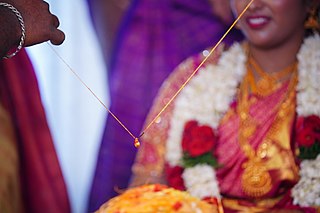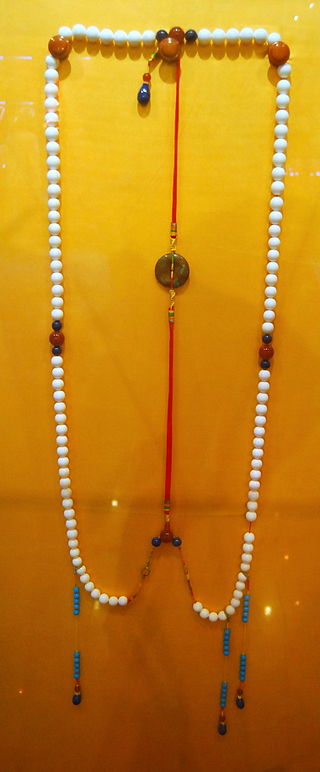
An Iraqi map pendant, usually worn on women's necklaces, has achieved some popularity as a symbol of Iraqi unity in the face of the widespread ethnic and sectarian violence in the country.

An Iraqi map pendant, usually worn on women's necklaces, has achieved some popularity as a symbol of Iraqi unity in the face of the widespread ethnic and sectarian violence in the country.
Necklaces with map pendants were sold before the 2003 invasion, but they were not especially common. They have gained currency thereafter, and especially as a statement against the subsequent development of communal violence and increased social balkanization.
The necklaces have been prominently worn by a number of Iraqi women television journalists. Many women have adopted the necklace in tribute to the life of journalist Atwar Bahjat, who was murdered in 2006.
The pendant necklaces are commonly sold in silver and gold, for the equivalent of about US$15 and $100 respectively.
Iraqi men have also worn map pendants as lapel pins, and some have pinned them to military uniforms.

Jewellery consists of decorative items worn for personal adornment such as brooches, rings, necklaces, earrings, pendants, bracelets, and cufflinks. Jewellery may be attached to the body or the clothes. From a western perspective, the term is restricted to durable ornaments, excluding flowers for example. For many centuries metal such as gold often combined with gemstones, has been the normal material for jewellery, but other materials such as glass, shells and other plant materials may be used.

A pendant is a loose-hanging piece of jewellery, generally attached by a small loop to a necklace, which may be known as a "pendant necklace". A pendant earring is an earring with a piece hanging down. Its name stems from the Latin word pendere and Old French word pendr, both of which translate to "to hang down". In modern French, pendant is the gerund form of pendre and also means "during". The extent to which the design of a pendant can be incorporated into an overall necklace makes it not always accurate to treat them as separate items.

A necklace is an article of jewellery that is worn around the neck. Necklaces may have been one of the earliest types of adornment worn by humans. They often serve ceremonial, religious, magical, or funerary purposes and are also used as symbols of wealth and status, given that they are commonly made of precious metals and stones.

A medal or medallion is a small portable artistic object, a thin disc, normally of metal, carrying a design, usually on both sides. They typically have a commemorative purpose of some kind, and many are presented as awards. They may be intended to be worn, suspended from clothing or jewellery in some way, although this has not always been the case. They may be struck like a coin by dies or die-cast in a mould.

A choker is a close-fitting necklace worn around the neck, typically 14 inch to 16 inch in length. Chokers can be made of a variety of materials, including velvet, plastic, beads, latex, leather, metal, such as silver, gold, or platinum, etc. They can be adorned in a variety of ways, including with sequins, studs, or a pendant.

In fashion, an accessory is an item used to contribute, in a secondary manner, to an individual's outfit. Accessories are often chosen to complete an outfit and complement the wearer's look. They have the capacity to further express an individual's identity and personality. Accessories come in different shapes, sizes, hues, etc. The term came into use in the 16th century.

A mangala sutra, or tali, is a necklace worn by married Hindu women. During a Hindu wedding, the mangalasutra is tied around the neck of the bride by the groom. The ceremony is known as the Mangalya Dharanam.
Jewelry of the Etruscan civilization existed in several eras.

Elizabeth II owned a historic collection of jewels – some as monarch and others as a private individual. They are separate from the gems and jewels of the Royal Collection, and from the coronation and state regalia that make up the Crown Jewels.
Attire of Mangalorean Catholics refers to the traditional clothing of the Mangalorean Catholics from the Mangalore Diocese on the southwestern coast of India.
Kandyan jewellery comes from the hill capital of Ceylon or Sri Lanka. The Kandyan Kingdom lasted till 1815 resulting in the original sets of jewellery and designs still being preserved and worn by Kandyan families today.

Native American jewelry refers to items of personal adornment, whether for personal use, sale or as art; examples of which include necklaces, earrings, bracelets, rings and pins, as well as ketohs, wampum, and labrets, made by one of the Indigenous peoples of the United States. Native American jewelry normally reflects the cultural diversity and history of its makers, but tribal groups have often borrowed and copied designs and methods from other, neighboring tribes or nations with which they had trade, and this practice continues today. Native American tribes continue to develop distinct aesthetics rooted in their personal artistic visions and cultural traditions. Artists may create jewelry for adornment, ceremonies, and display, or for sale or trade. Lois Sherr Dubin writes, "[i]n the absence of written languages, adornment became an important element of Indian communication, conveying many levels of information." Later, jewelry and personal adornment "...signaled resistance to assimilation. It remains a major statement of tribal and individual identity."

The wedding dress of Princess Louise, Queen Victoria's sixth child and fourth daughter, was worn by her at her wedding to John Campbell, Marquess of Lorne, the heir-apparent to the 8th Duke of Argyll, on 21 March 1871 at St. George’s Chapel, Windsor Castle.
Norigae (Korean: 노리개) is a typical, traditional Korean accessory used in Hanbok, which can be hung on goreum of a woman's jeogori or on her chima. The norigae functions as a decorative pendant and is both a good-luck charm hoped to bring something such as eternal youth, wealth or many sons, as well as a fashion accessory. Usually, the norigae from the parents' or in-laws' home was passed down to descendants.

A cross necklace is any necklace featuring a Christian cross or crucifix as its pendant.

Ancient Roman jewelry was characterized by an interest in colored gemstones and glass, in contrast with their Greek predecessors who focused primarily on the production of high-quality metalwork by practiced artisans. Extensive control of Mediterranean territories provided an abundance of natural resources to utilize in jewelry making. Participation in trade allowed access to both semi-precious and precious stones that traveled down the Persian Silk Road from the East.

Diana, Princess of Wales, owned a collection of jewels both as a member of the British royal family and as a private individual. These were separate from the coronation and state regalia of the crown jewels. Most of her jewels were either presents from foreign royalty, on loan from Queen Elizabeth II, wedding presents, purchased by Diana herself, or heirlooms belonging to the Spencer family.

Jewellery of the Berber cultures is a historical style of traditional jewellery that was worn by women mainly in rural areas of the Maghreb region in North Africa and inhabited by Indigenous Berber people. Following long social and cultural traditions, Berber or other silversmiths in Morocco, Algeria and neighbouring countries created intricate jewellery with distinct regional variations. In many towns and cities, there were Jewish silversmiths, who produced both jewellery in specific Berber styles as well as in other styles, adapting to changing techniques and artistic innovations.

Yupei is a generic term for jade pendants. Yupei were popular even before Confucius was born. Jade culture is an important component of Chinese culture, reflecting both the material and spiritual culture. Jade is deeply ingrained in Chinese culture and played a role in every aspect of social life; it is also associated with positive qualities and aspects such as purity, excellence, and harmony.Jade is even more valued than gold in Chinese culture. The history of the art of jade carving in China to make ornaments, including dress ornaments, extends back to before 5000 BC. Ancient Chinese held even greater importance to yupei after it was regarded as a moral integrity by Confucius. Yupei could be used as belt or waist ornaments and as necklaces which appeared as early as the Liangzhu culture. Strings of jade pendant are also used to decorate headwear, such as the mianguan.

Chaozhu, also known as Court necklace and Mandarin necklaces in English, is a type of necklace worn as an essential element of the Qing dynasty Court clothing uniform. Chaozhu were worn by the Qing dynasty Emperors and members of the Imperial family, by imperial civil officials from the 1st to the 5th rank and the military official above the 4th rank.